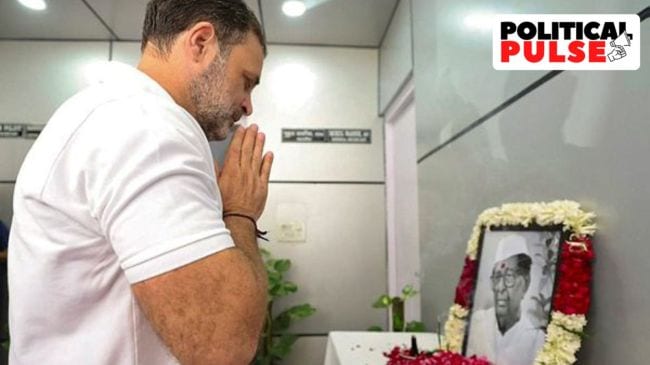Bihar polls days away, Congress remembers ‘forgotten’ party chief Sitaram Kesri on 25th death anniversary
Rahul Gandhi leads tributes even as PM Modi at Samastipur rally recalls Kesri’s unceremonious exit to target the Opposition party and the Gandhi family.
 Congress leader Rahul Gandhi pays tribute to former party president Sitaram Kesri on his death anniversary at the party office, in New Delhi. (Photo: AICC via PTI)
Congress leader Rahul Gandhi pays tribute to former party president Sitaram Kesri on his death anniversary at the party office, in New Delhi. (Photo: AICC via PTI) In the All India Congress Committee’s (AICC) annual calendar, October 24 has not been a date of any special significance for years. But this year marked a difference, with the party in the thick of the crucial Bihar Assembly elections.
Springing a surprise, the Congress on Friday chose to observe the 25th death anniversary of its former president Sitaram Kesri, the Gandhi-cap-donning veteran OBC leader from Bihar who succeeded P V Narasimha Rao as party chief in 1996 but was unceremoniously forced out two years later to make way for Sonia Gandhi.
Though the tenures of both Rao and Kesri seem to have faded into forgotten chapters of the party’s history, Leader of Opposition Rahul Gandhi turned up at the AICC headquarters to pay tributes to Kesri.
The Congress’s gesture took many within the party by surprise. “Achi baat hai. Der aaye durust aaye… hona chahiye (It is a good thing… better late than never),” said Congress Working Committee (CWC) member Tariq Anwar, who was Kesri’s political secretary and a close associate.
Anwar told The Indian Express that Kesri was a freedom fighter who rose from being a bandmaster in the Seva Dal to the post of Congress president. Kesri hailed from the Bania caste, which figures in Bihar’s list of backward classes.
Even as the Congress’s move is being viewed by some as an attempt to blunt the BJP’s campaign pitch during the Bihar polls, another leader termed it “hypocrisy of the worst order”.
The tribute to Kesri also drew a sharp reaction from Prime Minister Narendra Modi, who launched his Bihar campaign the same day. “Today is the death anniversary of former Congress president Sitaram Kesri. The country will never forget how this Congress family insulted him. Today reminds us of the lengths to which Congress will go to take away the rights of Dalits and backward classes. For these people, only their own family is paramount. Kesri was the pride of our Bihar but this family locked him in the bathroom. Not only that, they picked him up and threw him on the footpath. They snatched the post of Congress president from him,” Modi said at a rally in Samastipur.
Earlier too, Modi had invoked Kesri’s ouster to attack the Congress over its commitment to social justice. In a speech in Parliament last year, the PM had said the Congress “disregarded democracy” by locking Kesri in a bathroom. “What happened to Kesri, who belonged to an extremely backward caste? He was locked in the bathroom, thrown on the footpath. The entire party is controlled by one family. They disregarded democracy,” he said.
In his autobiography, former Congress leader Ghulam Nabi Azad, who later fell out with Kesri, claimed it was he who proposed Kesri’s name as party president because he “was the only CWC member who still dons a Gandhi cap”.
Recounting events at the CWC meeting held after the Congress’s 1996 Lok Sabha defeat, Azad wrote that he told Rao that although he had been “one of the best Prime Ministers,” he was the “worst president” the Congress had seen. “‘You had no interest, aptitude or time for organisational work. This is the reason why we lost the elections,’ I continued as Rao listened impassively.”
The 1998 Lok Sabha defeat, which saw the Congress restricted to 141 seats, turned the wheel for Kesri. “A CWC meeting was called to introspect on the loss. Many senior leaders, including me, believed that the main reason for the poor performance was Kesri’s lacklustre leadership. In the past, leaders such as Nehru, Indira ji and Rajiv had not only provided effective leadership to the country and the organisation but also been our star election campaigners. Kesri, on the other hand, failed to give us that leadership and was a poor campaigner too. He would have to relinquish his post so that the party could choose a younger and more effective president,” Azad wrote.
While senior leaders wanted Kesri to quit and make way for Sonia, he was unwilling to step down, despite having earlier indicated that he would. He left the meeting dejected but without giving any signal that he would accede to the party’s demand, Azad recalled in his book.
Former President and Congress stalwart Pranab Mukherjee then drafted a cleverly worded resolution that the CWC passed on March 14, 1998, to remove Kesri. “This meeting of the CWC takes note of the special situation arising out of the public announcement of Sitaram Kesri to resign from the office of the Congress president in favour of Sonia Gandhi at a press conference on March 9 at the AICC headquarters … After considering the special situation since this announcement, the CWC feels that the organisational work has come to a standstill and that a hiatus has been created in the smooth functioning of the party. To remove the confusion and state of uncertainty leading to irreparable and immense harm to the party, the CWC resolves to appoint Sonia Gandhi as Congress president in exercise of the powers conferred in clause J of Article 19 of the Congress constitution with immediate effect,” the resolution stated.
“Sonia ji’s name was proposed as Kesri’s replacement, and there was unanimity on the choice among the party’s senior leaders. In the limited campaigning that she had done, she had struck a chord with the people. As part of the Nehru-Gandhi family, she commanded respect and admiration within the Congress. The challenge was to convince her to enter active politics,” Azad recalled.
Senior Congress leaders Sharad Pawar, who subsequently broke away from the party, and A K Antony were then sent to Sonia’s residence to persuade her. Azad too joined them. “Sonia ji was ready but wanted six more months. The leaders, however, managed to convince her. Sonia ji was lost in thought. After about five minutes, she looked up and said she was ready to take on the mantle. We were relieved and happy. The CWC thereafter lost no time in passing another resolution electing her as the president, of course in her absence,” Azad wrote.
Then the high drama unfolded. Party old-timers recall that Ahmed Patel and Oscar Fernandes, both of whom are no longer alive, soon replaced Kesri’s nameplate with Sonia’s outside the Congress president’s office. AICC lore has it that Kesri was locked in the bathroom during the transition.






